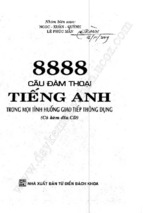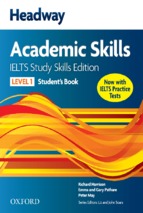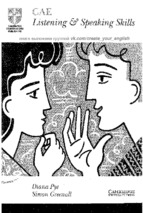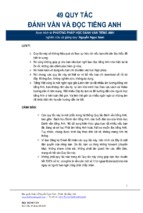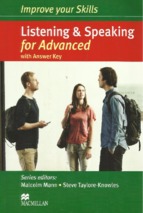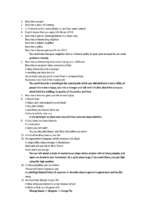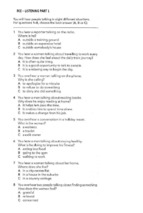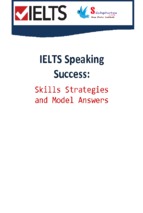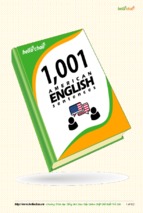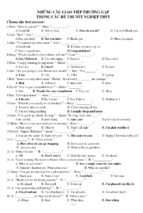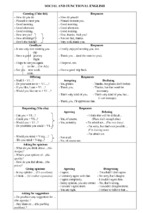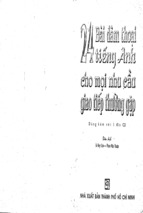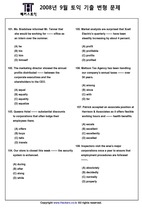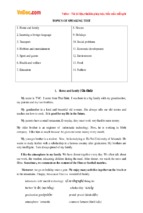Mô tả:
rubrics for presentation
RUBRICS FOR EAP PRESENTATION – SCORES DESCRIPTOR
Assessment Criteria
(1-2)
(3-5)
(6-8)
(9-10)
1. Formulates an introduction
that orients audience to topic
and speaker
No opening technique; no
credibility statement; no
background on topic; no thesis;
no preview of points
Irrelevant opening; little
attempt to build credibility;
abrupt jump into body of
speech; thesis and main points
can be deduced but are not
explicitly stated
Average attention getter;
some-what develops
credibility; awkwardly
composed thesis; provides
little direction for audience
Good attention getter; generally
establishes credibility; provides
some orientation to topic;
discernible thesis; previews
main points
2. Uses an effective
organizational pattern
No organizational pattern; no
transitions; sounded as if
information was randomly
presented
Speech did not flow well;
speech was not logically
organized; transitions
present but not well formed
Organizational pattern
somewhat evident; main points
are present but not mutually
exclusive; transitions are
present but are minimally
effective
Organizational pattern is
evident, main points are
apparent; transitions present
between main points; some
use of signposts
3. Locates, synthesizes and
employs compelling
supporting materials
Supporting materials are nonexistent or are not cited
Some points were not
supported; a greater quantity/
quality of material needed;
some sources of very poor
quality
Points were generally supported
using an adequate mix of
materials; some evidence
supports thesis; source citations
need to be clarified
Main points were supported
with appropriate material;
sources correspond suitably to
thesis; nearly all sources cited
4. Develops a conclusion that
reinforces the topic and
provides psychological
closure
No conclusion; speech ends
abruptly and without closure
Conclusion lacks clarity; trails
off; ends in a tone at odds with
the rest of the speech
Provides some summary of
points; no clear reference back
to thesis; closing technique can
be strengthened
Appropriate summary of
points; some reference back to
thesis; clear clincher or call to
action
5. Demonstrates an
accuracy use of grammar &
vocabulary
Many errors in grammar and
syntax; extensive use of jargon,
slang, sexist/racist terms or
mispronunciations
Grammar and syntax need to
be improved as can level of
language sophistication;
occasionally biased
Language selection adequate;
some errors in grammar;
language at times misused (e.g.
jargon, slang, awkward
structure)
Language appropriate to the
goals of the presentation; no
conspicuous errors in grammar;
no evidence of bias
6. Pronounces accurately
and effectively uses VOICE
to engage the audience
Numerous pronunciation errors
during course of presentation
with no attempt made at the use
of stress and intonation; Speaks
inaudibly; enunciates poorly;
speaks in monotone; poor
pacing; distracts listeners with
fillers
Numerous individual word
pronunciation errors with little
attempt at the use of stress and
intonation to underline
meaning;
Sometimes uses a voice too
soft or articulation too
indistinct for listeners to
comfortably hear; often uses
fillers
Strong attempt at using
stress and intonation during
the course of the
presentation; some
individual word
pronunciation errors;
Demonstrates some vocal
variation; enunciates clearly
and speaks audibly;
generally avoids fillers
(e.g. um, uh, like)
Clear understanding of stress
and intonation with very few
basic errors in pronunciation at
the level of individual words;
Good vocal variation and pace;
vocal expression suited to
assignment; few if any fillers
7. Demonstrates nonverbal
behavior that supports the
verbal message
Usually looks down and avoids
eye contact; nervous gestures
and nonverbal behaviors
distract from or contradict the
message
Speaker relies heavily on notes;
nonverbal expression stiff and
unnatural
Some reliance on notes, but
has adequate eye contact,
generally avoids distracting
mannerisms
Postures, gestures and facial
expressions are suitable for
speech, speaker appears
confident
8. Satisfactorily answers the
questions and explains
terminology
Fails to understand the
questions and shows little
knowledge of the topic
Partially understands the
questions and provide
insufficient answers, shows
inadequate knowledge of the
subject
Correctly understands and
provides irrelevant answers;
shows adequate knowledge of
the subjects
Fully understands and
satisfactorily answers the
questions; demonstrates
profound understanding of the
subjects
9. Skillfully makes use of
visual aids
Use of the visual aids
distracted from the speech;
visual aids not relevant;
visual aids poor professional
quality
Speaker did not seem well
practiced with visuals; visuals
not fully explained; quality of
visuals needs improvement
Visual aids were generally well
displayed and explained; minor
errors present in visuals
Visual aids well presented; use
of visual aids enhances
understanding; visual aids good
quality
10. Overall impression
Presenter seemed to have no
preparation, no respect towards
the audience, have no
connection with the audience.
Presenter seemed to be
unprepared, slightly distant
from audience
Presenter appeared to be not
very well prepared, attempted
to communicate with the
audience at very limited level.
Presenter showed visible
efforts of preparation,
generally communicated with
audience, though he or she
became distracted from time to
time
- Xem thêm -




